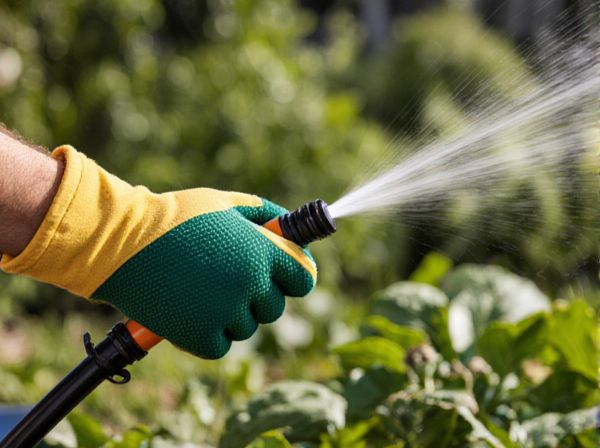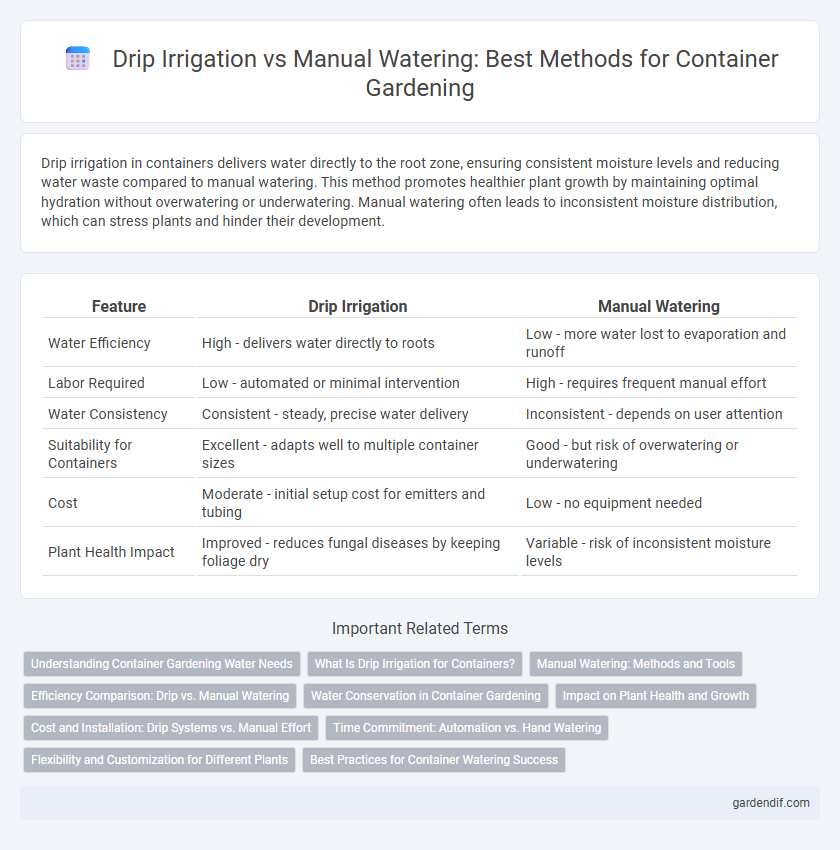
Drip irrigation vs manual watering in containers Illustration
Drip irrigation in containers delivers water directly to the root zone, ensuring consistent moisture levels and reducing water waste compared to manual watering. This method promotes healthier plant growth by maintaining optimal hydration without overwatering or underwatering. Manual watering often leads to inconsistent moisture distribution, which can stress plants and hinder their development.
Table of Comparison
| Feature | Drip Irrigation | Manual Watering |
|---|---|---|
| Water Efficiency | High - delivers water directly to roots | Low - more water lost to evaporation and runoff |
| Labor Required | Low - automated or minimal intervention | High - requires frequent manual effort |
| Water Consistency | Consistent - steady, precise water delivery | Inconsistent - depends on user attention |
| Suitability for Containers | Excellent - adapts well to multiple container sizes | Good - but risk of overwatering or underwatering |
| Cost | Moderate - initial setup cost for emitters and tubing | Low - no equipment needed |
| Plant Health Impact | Improved - reduces fungal diseases by keeping foliage dry | Variable - risk of inconsistent moisture levels |
Understanding Container Gardening Water Needs
Drip irrigation delivers water directly to the root zone in containers, minimizing evaporation and runoff, which ensures consistent soil moisture levels crucial for plant health. Manual watering often leads to uneven moisture distribution, risking overwatering or underwatering, which can stress container plants. Understanding the specific water requirements of container plants and utilizing drip irrigation systems enhances water efficiency and promotes optimal growth.
What Is Drip Irrigation for Containers?
Drip irrigation for containers is a precise watering method that delivers water directly to the root zone through a network of tubes and emitters, minimizing water waste and runoff. This system maintains consistent soil moisture, promotes healthier plant growth, and reduces the risk of overwatering compared to manual watering. Automated drip irrigation optimizes water efficiency and saves time, making it ideal for urban gardening and container plants.
Manual Watering: Methods and Tools
Manual watering in container gardening involves using tools such as watering cans, hose-end sprayers, or hand-held hoses, enabling precise control over water volume and targeting specific plants. This method allows gardeners to monitor soil moisture levels closely, reducing the risk of overwatering or underwatering. Regular manual watering supports healthier root development and can help identify early signs of plant stress or disease.
Efficiency Comparison: Drip vs. Manual Watering
Drip irrigation delivers water directly to the root zone in controlled amounts, significantly reducing water waste compared to manual watering, which often results in uneven distribution and evaporation loss. This method enhances water use efficiency by up to 50%, promoting healthier plant growth within containers. Manual watering requires more time and labor, whereas drip systems provide consistent moisture with minimal intervention, optimizing water consumption and container plant health.
Water Conservation in Container Gardening
Drip irrigation in container gardening significantly reduces water usage by delivering precise amounts directly to the plant roots, minimizing evaporation and runoff compared to manual watering. This method enhances water conservation by ensuring efficient moisture distribution, leading to healthier plants with less water waste. Studies show drip irrigation can save up to 50% more water than manual watering in container setups.
Impact on Plant Health and Growth
Drip irrigation in containers delivers water directly to the root zone, maintaining consistent soil moisture and reducing the risk of overwatering or underwatering, which promotes optimal plant health and growth. Manual watering often results in uneven moisture distribution, causing stress to plants and potentially leading to fungal diseases or root rot. Consistent hydration from drip irrigation supports robust root development and enhances nutrient uptake, leading to healthier, more vigorous container plants.
Cost and Installation: Drip Systems vs. Manual Effort
Drip irrigation systems for containers typically involve a higher initial cost due to components like tubing, emitters, and timers, but offer long-term savings in water usage and time. Manual watering requires minimal startup investment but demands consistent physical effort and may result in uneven moisture distribution. Installing a drip system generally requires knowledge of layout and assembly, while manual watering needs only a watering can or hose, making it more accessible but less efficient.
Time Commitment: Automation vs. Hand Watering
Drip irrigation systems significantly reduce time commitment by automating water delivery, ensuring consistent moisture levels in containers without daily attention. Manual watering demands frequent, hands-on effort, increasing labor, especially for multiple or large container setups. Automation also minimizes water waste and optimizes plant health by providing precise, scheduled hydration that hand watering often cannot achieve consistently.
Flexibility and Customization for Different Plants
Drip irrigation systems offer precise control over water delivery, allowing for tailored moisture levels suited to different plant species within the same container setup. Manual watering can lead to inconsistent moisture distribution and potential over- or under-watering, especially when multiple plants with varied needs share a container. Utilizing drip irrigation enhances flexibility and customization by enabling adjustable flow rates and scheduling, optimizing plant health and growth efficiency.
Best Practices for Container Watering Success
Drip irrigation provides consistent moisture levels essential for optimal container plant growth, reducing water waste and preventing root rot caused by overwatering. Manual watering can lead to uneven hydration and stress in container plants due to inconsistent watering patterns and difficulty in thoroughly soaking the root zone. To achieve container watering success, implement a drip irrigation system with timers and moisture sensors to maintain ideal soil moisture, ensuring healthy, vigorous plants.
Drip irrigation vs manual watering in containers Infographic

 gardendif.com
gardendif.com